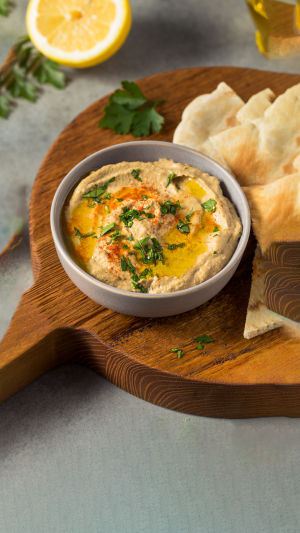Baba ghanoush, with its rich and smoky flavour, is a testament to Middle Eastern cuisine's exquisite tapestry.
This traditional dish, originating from the Levant region, has gained widespread popularity for its unique taste and versatility.
In this article, we will embark on a culinary journey exploring the origins, preparation, and cultural significance of baba ghanoush, delving into the heart of a dish that has captured the palates of food enthusiasts worldwide.
Origins of Baba Ghanoush:
Baba ghanoush traces its roots back to the Middle East, particularly in countries like Lebanon, Syria, and Palestine. The name is derived from Arabic, with "baba" meaning father and "ghanoush" roughly translating to pampered or spoiled.
The dish's nomenclature suggests a particular indulgence or luxuriousness, which is fitting considering its rich and velvety texture.
Ingredients and Preparation:
The primary ingredient in baba ghanoush is the humble eggplant, which takes centre stage in this delectable dish. The eggplant is typically roasted or grilled, imparting a smoky flavour that becomes the hallmark of baba ghanoush.
Other essential ingredients include tahini (sesame paste), garlic, lemon juice, and olive oil, all working together to create a harmonious blend of flavours.
To prepare baba ghanoush, the eggplant is first charred over an open flame or on a grill. This process imparts the desired smokiness and softens the flesh, making it easier to work with.
Once charred, the eggplant is peeled, and the flesh is mashed or pureed. Tahini, minced garlic, lemon juice, and olive oil add a luscious and velvety dip. Salt, pepper, and sometimes cumin are incorporated to enhance the overall flavour profile.
Cultural Significance:
Baba ghanoush is special in Middle Eastern cuisine, often served as a mezze (appetizer) alongside other favourites like hummus, tabbouleh, and falafel.
Its popularity extends beyond the region, with people worldwide embracing the dish for its unique taste and health benefits. Including eggplant, a low-calorie and nutrient-rich vegetable, makes baba ghanoush a wholesome and satisfying choice for health-conscious individuals.
Moreover, baba ghanoush reflects the region's emphasis on fresh, locally sourced ingredients and the art of transforming simple components into culinary masterpieces.
Its popularity has transcended cultural boundaries, becoming a staple in many international cuisines and earning a place on restaurant menus worldwide.
Pairings and Serving Suggestions:
Baba ghanoush is a versatile dish that can be enjoyed in various ways. It is commonly served as a dip with pita bread or fresh vegetables, providing a delightful contrast of textures and flavours.
Additionally, it can be used as a spread in sandwiches or wraps, adding a creamy and savoury element to the overall composition.
Baba ghanoush can be paired with grilled meats, rice dishes, or other mezze items for a complete Middle Eastern feast. Its ability to complement various foods makes it a favourite for casual gatherings and formal occasions.
Conclusion:
In conclusion, baba ghanoush stands as a culinary gem, embodying the rich tapestry of Middle Eastern cuisine. From humble origins to widespread global popularity, this smoky and velvety dish has captivated taste buds and symbolised the region's culinary excellence.
Whether enjoyed as a dip, spread, or accompaniment, baba ghanoush continues to delight food enthusiasts, inviting them to savour the essence of Middle Eastern flavours with every delectable bite.





